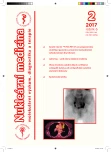As time went – arising of the nuclear medicine specialty
Authors:
Hana Materová
Authors‘ workplace:
LF Ostravské univerzity v Ostravě, ČR
; Klinika nukleární medicíny FN v Ostravě a Katedra biomedicínských oborů
Published in:
NuklMed 2017;6:28-31
Category:
Review Article
Overview
We frequently ask how nuclear medicine emerged, what preceded, how the evolution came to the present days. As we looked into the history, we can see that the oldest medical record is dated approximately to the year 2050 BC, the most famous physician of the Ancient Greece Hippokrates lived around the year 400 BC and the Greek philosopher Demokritos described the atomic theory of mass at the same era. Board examinations were introduced in Rome at the year 200 AD and degree MD was established in the Italian city Salerno at the year 1180 AD.
Medicine underwent a monumental development thanks to discoveries in biology, physics and chemistry in the 19th and 20th centuries awarded with several Nobel prices. Wilhelm Röntgen discovered X-ray in 1895, Henry Becquerel natural radioactivity in 1896 and ionizing radiation started to be used for therapeutic and diagnostic purposes in 1897.
Personal dosimeters were used during operation with radiation but personal dosimetry as a discipline emerged only in the seventieths. It is a long time from the thirtieth, when E. O. Lawrence assembled the first cyclotron, J. Chadwick discovered a neutron, radionuclide 99mTc was prepared from 99Mo and radioactive iodine begun to be used to treat thyroid gland thanks to G. Seaborg. Turning point for nuclear medicine was the year 1950 when Hal O. Anger assembled a scintillation gamma camera. This type from 1957 is still in use. SPECT and PET cameras followed and hybrid systems SPECT/CT, PET/CT and PET/MR emerged at the beginning of the 21st century.
Of course, professional societies and other institutions were established together with the specialty.
Key Words:
nuclear medicine, history, specialty formation
Sources
1. Institut Galenus [online]. [cit. 2017-03-17]. Dostupné na: http://galenus.cz/clanky/zdravi/historie-prehled
2. Dějiny lékařství - Wikiskripta [online]. [cit. 2017-03-17]. Dostupné na: http://www.wikiskripta.eu/index.php/Portál:Dějiny_lékařství
3. History of nuclear medicine [online]. [cit. 2017-03-17]. Dostupné na: http://www.news-medical.net/health/History-of-Nuclear-Medicine.aspx
4. History of medical imaging [online]. [cit. 2017-03-17]. Dostupné na: http://www.infinityugent.be/research-development/a-history-of-medical-imaging
5. Brucer M. Nuclear medicine begins with a boa constrictor. J Nucl Med 1978;19:581-598
6. The society of Nuclear Medicine and Molecular Imaging [online]. [cit. 2017-03-17]. Dostupné na: http://www.snmmi.org/
7. British Nuclear Medicine Society [online]. [cit. 2017-03-17]. Dostupné na: http://www.bnms.org.uk/images/stories/Radioactivity.pdf
8. From Radioisotopes to medical imaging, history of nuclear medicine written at Berkeley [online]. [cit. 2017-03-17]. Dostupné na: http://www2.lbl.gov/Science-Articles/Archive/nuclear-med-history.html
9. Carlson S. A glance at the history of nuclear medicine. ActaOncologica 1995;34:1095-1102
10. Feld M, De Roo M. History of nuclear medicine in Europe Stuttgart, Schattauer GmbH, New York, 2003, 166 p.
11. The European Association of Nuclear Medicine [online]. [cit. 2017-03-17]. Dostupné na: http://www.eanm.org/
12. Česká Společnost nukleární medicíny [online]. [cit. 2017-03-17]. Dostupné na: https://www.csnm.cz/article/show/actuality/default
Labels
Nuclear medicine Radiodiagnostics RadiotherapyArticle was published in
Nuclear Medicine

2017 Issue 2
Most read in this issue
- As time went – arising of the nuclear medicine specialty
- Sacral chordoma pattern on three-phase bone scan and leukocyte scan
- Application of 18F-FDG PET/CT in prognostic stratification of patients with primary mediastinal diffuse large B-cell lymphoma
